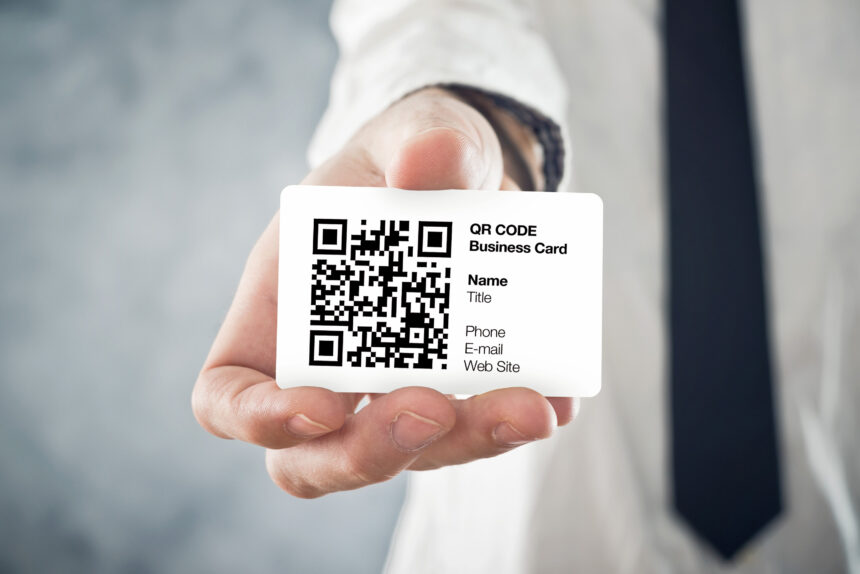QR code business cards are changing how professionals share contact information, blending traditional networking with modern technology. However, creating an effective QR code card isn’t as simple as it might seem. By understanding common pitfalls, you can ensure your card stands out for the right reasons and becomes a powerful networking tool.
- Avoid These Mistakes
- 1. Overcomplicating the Business Card Design
- 2. Using a Low-Quality QR Code
- 3. Forgetting to Test the QR Code
- 4. Neglecting Mobile Optimization
- 5. Not Providing Context
- 6. Using an Unstable URL
- 7. Ignoring Color Contrast
- 8. Making the QR Code Too Small
- 9. Overlooking Error Correction
- 10. Failing to Provide Alternative Contact Methods
- 11. Not Considering Print Quality
- 12. Overloading with Information
- 13. Ignoring Analytics
- 14. Choosing the Wrong QR Code Type
- 15. Neglecting Security
- Conclusion
Avoid These Mistakes
In creating a QR code business code, avoid:
1. Overcomplicating the Business Card Design
Keep it simple. A cluttered design can confuse people and make your QR code hard to scan. Stick to the essentials: your name, contact details, and the QR code itself.
Don’t try to cram every detail of your work history onto the card. Instead, use white space effectively to make your card look clean and professional. Consider using a minimalist design for your QR code business card with just one or two colors besides black and white. This approach not only looks sleek but also ensures your QR code stands out.
2. Using a Low-Quality QR Code
A blurry or pixelated QR code is useless. Make sure your code is high-resolution and easily scannable. Use a reputable QR code generator and download the image in a vector format if possible. This will help maintain clarity even when resized.
When placing the QR code on your card, give it enough breathing room. Don’t let other QR code design elements crowd it or overlap with it. A good rule of thumb is to leave a quiet zone (empty space) around the QR code that’s at least four times the width of a single module (the smallest square in the QR code).
3. Forgetting to Test the QR Code
Always test your code before mass-producing your QR business cards. Scan it with different phones and in various lighting conditions to make sure it’s reliable. Test it outdoors, indoors, under bright lights, and in dimmer conditions.

Also, try scanning your code from different angles. A good QR code should be readable even when not perfectly aligned with the camera. If you’re having trouble scanning your code consistently, it might be time to simplify its content or increase its size.
4. Neglecting Mobile Optimization
Where does your QR code lead? If it’s a website, make sure it’s mobile-friendly. Most people will scan your code with their phones, so your landing page should look good on small screens.
Consider creating a specific mobile landing page for your QR code. This page should load quickly and be easy to navigate on a smartphone. Include clear calls-to-action and make sure any forms are easy to fill out on a mobile device.
5. Not Providing Context
Don’t just slap a QR code on your card without explanation. Give people a reason to scan it. A simple ‘Scan for more info’ or ‘View my portfolio’ can make a big difference.
You could also use icons or small graphics to hint at what people will find when they scan the code. For example, if the code leads to your social media profiles, you could include small social media icons next to the QR code.
6. Using an Unstable URL
If your QR code leads to a website, make sure that URL won’t change. Using a temporary link or one that might change later will render your cards useless over time.
Consider using a URL shortener that allows you to change the destination without altering the QR code. This gives you the flexibility to update your linked content without having to reprint your cards. Some QR code generators offer this feature built-in, allowing you to create dynamic QR codes that you can edit later.
7. Ignoring Color Contrast
The colors you choose for your QR code and background matter. High contrast (like black on white) works best. Avoid light colors on light backgrounds or dark on dark.
While it’s possible to create colorful QR codes, be cautious. Stick to dark colors on light backgrounds or vice versa. If you want to use your brand colors, consider using them for the background or other design elements, keeping the QR code itself high-contrast.
8. Making the QR Code Too Small
If the code is too tiny, cameras might struggle to read it. A good rule of thumb is to keep your QR code no smaller than 2 cm x 2 cm.
However, don’t make it too large either. A QR code that takes up half your business card can look overwhelming. Aim for a size that’s easily noticeable but doesn’t dominate the card. The ideal size often depends on the amount of data in your QR code – more data requires a slightly larger size for reliable scanning.
9. Overlooking Error Correction
QR codes have built-in error correction, allowing them to be read even if partially damaged or obscured. There are four levels of error correction: L (7% recovery), M (15% recovery), Q (25% recovery), and H (30% recovery).
Higher error correction means less data capacity but more durability. For business cards that might get scratched or dirty in a wallet, consider using the M or Q level. This provides a good balance between data capacity and scan reliability.
10. Failing to Provide Alternative Contact Methods
Always include basic contact info like your email or phone number on the card itself. This gives people options and ensures you’re reachable even if there’s an issue with the QR code.
Consider which contact methods are most relevant to your business. If you’re in a creative field, you might include your Instagram handle. For a more corporate setting, your LinkedIn URL might be appropriate.
11. Not Considering Print Quality
The quality of your printed card affects how well the QR code works. Invest in good card stock and a reliable printer. Glossy finishes can sometimes cause glare that makes QR codes harder to scan, so a matte finish is often a safer choice.
If you’re ordering cards from a printing service, ask for proof and test the QR code before approving a large order. Some printing methods or papers may not reproduce the crisp edges needed for an easily scannable QR code.
12. Overloading with Information
Just because a QR code can store lots of data doesn’t mean it should. The more information you pack into a QR code, the more complex it becomes, potentially making it harder to scan.
Stick to essential info and use the code to link to more detailed content online. A good strategy is to create a simple landing page that acts as a hub, linking out to your various online profiles or resources. This keeps your QR code simple while still providing access to all your information.
13. Ignoring Analytics
Many QR code generators offer tracking and analytics. These tools can show you how often and where your code is scanned. Use this data to understand how effective your business card is and where your networking efforts are paying off.
Some advanced analytics can even show you what type of device was used to scan your code or what time of day most scans occur. This information can help you optimize your linked content for your audience.
14. Choosing the Wrong QR Code Type
There are different types of QR codes for different purposes. Some store contact info directly (vCard QR codes), while others just contain a URL. Make sure you’re using the right type for your needs.
A vCard QR code can be convenient as it allows the recipient to immediately save your contact info to their phone. However, a URL QR code gives you more flexibility to update and expand the information you share.
15. Neglecting Security
If your QR code leads to sensitive information, consider using a secure or dynamic QR code that you can control access to. This can help protect your personal or business data.
Some QR code generators offer password protection features. This means users would need to enter a password after scanning before they can access your information. While this adds an extra step, it can be useful for sharing confidential data.
Conclusion
Creating an effective QR code business card requires careful planning and attention to detail. By avoiding the common mistakes outlined here, you’ll design a card that looks professional and functions flawlessly. Remember, your business card often makes the first impression, so take the time to create one that showcases your tech-savvy approach and sets you apart.














